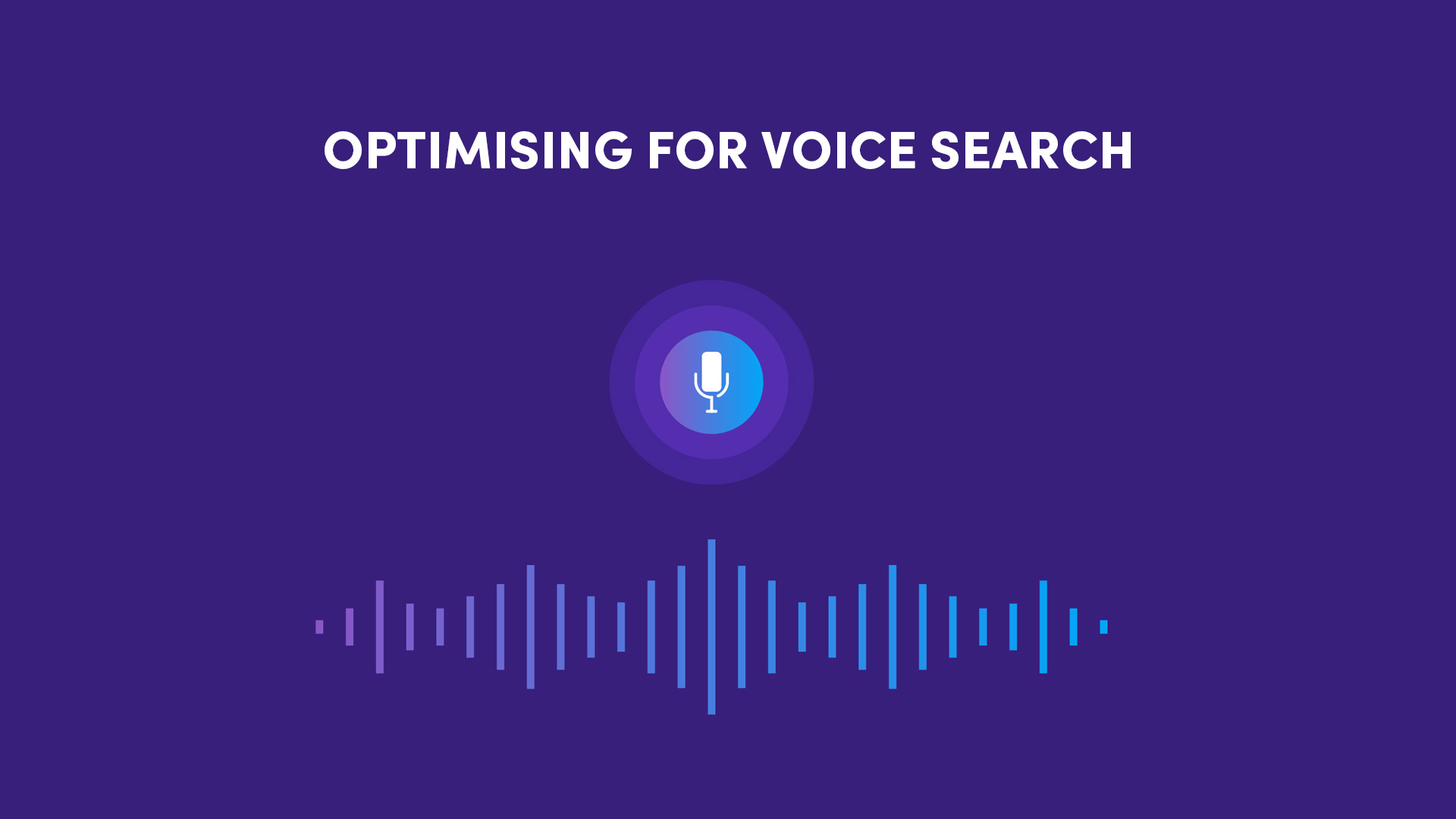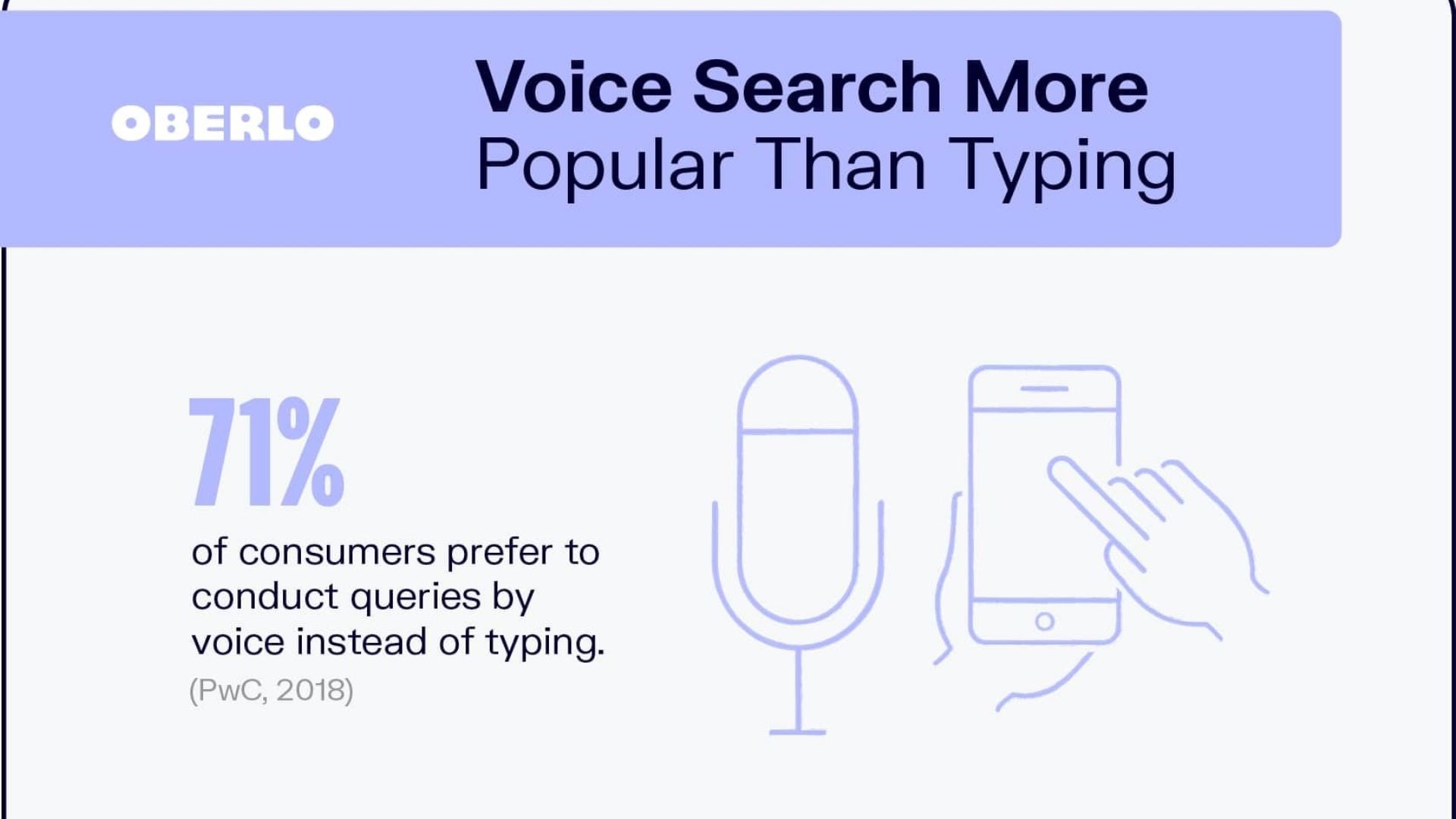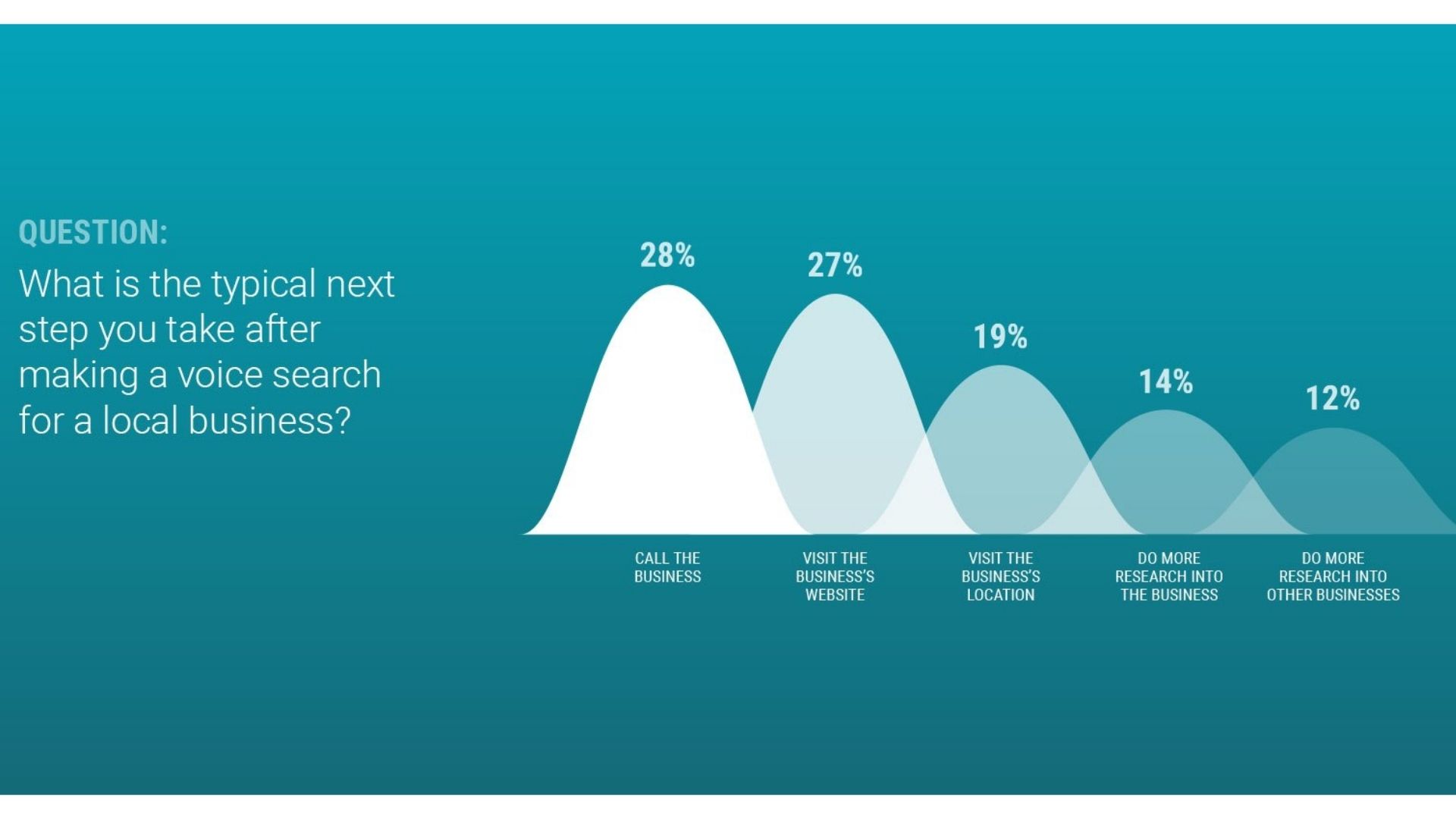Stephen Hawking said, “Be curious and try to make sense of what makes the universe exist.”
If you are driven by curiosity, you might be online most of the time searching for answers. But you don’t need to be a physicist to be curious — daily issues like where to eat or how to navigate a new locality are challenging enough.

That’s why search engines like Google move towards voice search, making it convenient for people to resolve their queries. Take out your phone, talk into the mic, and wait for the search results to populate.
However, the bigger question is: how does Google voice search work, and what SEO strategies can you apply to incorporate it into a website? For all the answers to get started with voice search optimisation, proceed to delve into our comprehensive guide.
Want to receive updates? Sign up to our newsletter
Each time a new blog is posted, you’ll receive a notification, it’s really that simple.
What Is Voice Search?
It’s no secret that people are part of the voice search revolution, discovering ways to optimise for voice search as a progressive approach to enhance their websites or local online business presence. This technological advancement manifests in the utilisation of dialogue systems.
A dialogue system is a computer setup with the basic purpose of carrying out a natural conversation with humans. Although it is called voice search, the system uses input and output data like speech/text or gestures to deliver accurate results.
In this context, you should know that the first natural language-speaking system dates back to 1977, so voice searches aren’t something new. The system has undergone regular development and changes to efficiently deliver precise responses to specific queries.
Now, every dialogue system comprises varying components, but One critical aspect for achieving ranking for voice search is the presence of a dialogue manager. For instance, Google Voice Search uses a dialogue manager that handles the semantics to formulate an effective dialogue strategy.

Automatic Speech Recognition
Modern voice search engine features Automatic Speech Recognition (ASR) to feed the data into the system. Additionally, some search engines use text-to-speech recognition to deliver results.
What’s impressive is that you won’t have to activate a virtual assistant like Google Assistant on any device before proceeding with a voice search. This is because the search device has the necessary input to detect the language of the user’s voice search queries.
Every voice search setup has a user query database that helps the algorithm shortlist the necessary keywords and display relevant search results. This is particularly relevant when it comes to enhancing your website for voice search on various devices, as results may be displayed or audibly provided by the voice assistant.
Grasping why voice search is important underscores its expedience and growing acceptance.
Why Is Voice Search Popular?
The main advantage of voice search is that it is faster and easier to operate. Suppose you are driving but want to turn on a voice-activated Google Maps service to find the correct route. What would be more straightforward — stopping abruptly amid traffic to conduct web searches for the right route or conveniently querying the voice assistant?
Like most people, you would prefer the latter because it’s convenient. Also, mobile users feel that voice search is an alternative to traditional text-based search, offering hands-free convenience apart from proving faster.
Voice search devices are fun, accurate, and much more straightforward than using an app or visiting a website. Issue voice commands and the smart device will take care of the rest.
We have shortlisted some of the points in favour of optimising for voice search to help you further:
1. Convenient
As mentioned earlier, convenience is the key when operating voice search while shopping, creating content or finding answers to common questions. Even though typing out questions is still very much in vogue, the future will likely consist of people using optimise for voice search to tell their smart devices what to do.
You can multitask easier with voice queries, spending every second on something worthwhile. In other words, why would you choose a more tedious option if there is a more straightforward way to do something?
Additionally, the impact of social media on regular communication bolsters the use of voice search, rendering it natural and universally accessible.
2. Avoiding Errors
Suppose you want to know about an off-route location in Switzerland, but unfortunately, you’re unaware of the spelling. You can try a simple voice search of places in Switzerland and follow that up with a question on the town or city of your choice.
In other words, people have to employ a trial-and-error method to type the name of a place when conducting a traditional search. But talking into the smart speakers (even though the pronunciation might be incorrect) allows the voice search assistant to understand the query quickly. Similarly, when you have trouble articulating the search query, you can spell out the keyword to find suitable resources on the subject.
Long story short, you can reduce errors significantly to find an answer for most queries via voice.
3. Mobile Devices
Remember when people used large handsets that covered their entire faces while taking a call? Neither do we because, thanks to swift advancements in technology, people opt for compact yet efficient devices, and tips for voice search SEO become relevant to cater to this trend.
Voice search is a big hit among mobile users who can access information with a simple voice query. As per the data from the latest research, 56% of people who often use voice search do so on their smartphones.
Compared to laptops, mobile phones fit inside your pocket and aren’t much larger than the palm of your hand. Add to that the voice assistant, and you’ve got a winning combination.
4. Location-Based Results
The good news is that Google Home and Amazon Echo come with location-based search results for frequently asked queries to streamline the user experience. If you want to search for local business listings, it is possible to use voice search according to your location.
Search engines will understand when you Google “My business listing”, delivering relevant results each time without specifying the place. This same principle is in play for “near me” Google searches.
This is only possible for local search queries; you’ll have to enable the GPS for this feature to work while travelling.
5. App-Based Search
Like location searches, voice queries provide promising results when using any particular Google app. For instance, if you’re looking at a food app and want to know the menu of a specific restaurant, you can use voice search to find the menu.
Your smart device is aware of your app and keeps track of recent searches to provide accurate answers.
6. Relevancy
The future of voice search is intricately linked to marketing and creating relevant content. People who create content must sit with web designers to incorporate voice search into the page to attract potential customers.
While making your content in a conversational tone is crucial, voice searchers must also be scope to engage in conversations.
Google categorises people into two types: those who type and talk. While the former group might want to conduct their research from the millions of search results, talkers generally want quick solutions.
They don’t have time to review the results and want the most relevant answer to their asked questions. To explain further, simply asking for your office address should be enough for Google to provide accurate results without needing to specify the details of your office.
Similarly, Google is developing conversational e-commerce sites to use voice search to make instant purchases. Naturally, shopping becomes easier as a verbal command is enough to find what you’re looking for.

Voice Search Vs Traditional Search: What’s Changed?
To truly understand the advancements in voice search and how SEO strategies have helped, let’s look at some of its promising features compared to traditional search.
1. Long-Tail Keywords
The keywords for voice search are longer than those for normal search because of how we humans speak. People use complete sentences when speaking on mobile phones, much like talking to friends.
The keywords are longer and conversational, while in traditional text-based searches, shorter texts suffice. Conversational queries in voice search require voice search keyword research, which is essential for long-tail phrases. Usually, 2-3 words are enough when typing a query, but the number of terms is double or triple when using a voice search.
As a result, the keyword research for voice search SEO strategies is different and varied.
2. Local Listings
Most voice search queries compromise “near me” questions; that’s why local listings are an essential part of voice searches. People often talk on their smart devices, looking for a restaurant, hotel or place to hang out.
Understandably, “near me” searches have grown considerably in the last few years. If you delve deeper, you will find that many customers want information on varied stuff, like movie timings or food menus.
Mostly, people use voice search to learn if local businesses in the vicinity have worthwhile business information to offer.

3. Prompt Response
The best part about voice search is that there is seldom any beating about the bush because most of the results are featured snippets. To explain more detail, Google relies on featured snippets and knowledge graphs to deliver accurate results.
Moreover, implementing long-tail keywords in your content is essential to serve quick answers demanded by today’s internet users with short attention spans. As a result, Google realises that direct answers are the need of the hour.
Thankfully, the featured snippets provide instant yet accurate query resolution since people don’t want to read huge chunks of content.
Types Of Keywords For Voice Search
As we move closer to voice search optimisation and suitable SEO strategies, it’s time to look at the most relevant keywords for voice searches.
1. Filler Words
Even though you can omit filler words while typing a question on Google, they are a must when using voice search. Terms or phrases like “I”, “the”, “on”, “of”, “for”, etc., make the questions more human, conversational and accessible for the search engine to understand.
2. Question Keywords
The primary purpose of question keywords is to clarify the Google Search engine. Incorporating words like “how” and “what” enhances prospects of appearing in voice search outcomes.
3. Long-Tail Keywords
As mentioned earlier, long-tail keywords often make a difference in a voice search. These words help complete the question and are crucial for optimising your SEO strategy.
Keyword Research
You already know about the most important keyword types for voice search, so it would help to include them in your keyword strategy for the best results. Specific tools are handy for keyword research, enabling your website to rank higher.
We’ve listed some of the popular reasons for using keyword research tools below:
1. Variety
You can’t know all the keywords, but you should know as many as possible to stay updated with consumer queries and market trends. For instance, keywords a rival web page uses or standard terms consumers prefer to use while searching are things you need to know.
That’s why keyword research tools generate variety, allowing you to update your database frequently.
2. Analytics
Some tools have a separate keyword analytics section to help you simultaneously deal with many topics. After searching for a keyword, the algorithm displays all the matching phrases, including terms similar to your search, allowing you to use more long-tail keywords.
3. Bonus Features
You may find bonus features whereby the tool lists the most common question keywords for optimising the voice search ranking. Additionally, you can search for a topic that will showcase popular questions related to that topic.
But how is this information helpful? You can contextually use these keywords or questions in your blog posts so that the featured snippet increases the rankings during a voice search.
Optimising Voice Search
With voice search becoming popular, more websites will be inclined to try out its features, so you must develop a suitable SEO strategy. But as voice search is more refined, your search engine optimisation architecture should match up accordingly for the web page to achieve a higher ranking.
In other words, content optimisation is the key, and we’ve narrowed down some of the best ways to do so:
1. Focus On Rich Answers
You might be wondering what rich answers are, so let us explain. According to a study, 70% of all voice search results carry a search engine results page (SERP) feature, while 60% have a featured snippet result.

This means that different people conducting a voice search about a particular query will get similar results, known as the rich answer for that question. Over the years, the number of search results with rich solutions has gone up, so you need to tweak your SEO strategy accordingly.
To qualify as a rich answer, it should have one or more of the following features:
A. Knowledge Graph
You must know that Google maintains a database or knowledge graph containing information about things, people, and places. Hence, marketing teams use Google’s knowledge graph to provide relevant answers to a search query.
We said people might find similar results for a voice search query, as Google often displays rich answers.
B. Knowledge Box
Rich answers comprise a knowledge box containing factual information. Like regular search engine results, the knowledge graph is integral to appearing in voice search.
C. Knowledge Panel
Have you noticed a small box to the right of the search results that carry snippets of information? This knowledge panel usually appears on the screen when you search for businesses, while the data comes from the knowledge graph.
D. Featured Snippet
Google displays the featured snippets on the organic search results, usually right above the ads. However, since these come from third-party sources, the search engine attributes the information to the source.
The prevalent use of the Google Voice search engine means featured snippets must deliver precise answers, aiding people to rapidly obtain the information they need.
2. Conversational Language
You should use conversational language to reap the full benefits of voice search queries. Sounding too technical or robotic makes it challenging for Google to understand and suggest the content to users.
Sticking to everyday language and natural terms while discussing any topic would be best. This will increase improving the chances of appearing in top search positions.
Moving on, since people prefer a conversational tone, having easy-to-read articles ensures search engines can conveniently match them to a query. You must understand user intent and determine how they frame a verbal query.
This foresight enables you to align with users’ search intent, guiding adjustments to the SEO strategy in accordance with the probable queries based on the website content. For example, you can create a database of the most relevant question keywords, people’s type of queries, and their conversation styles.
This information will permit you to formulate relevant answers while researching how successful rival websites are in writing content. Opting for a data-driven strategy will help you address people’s needs in a mobile-friendly manner using voice search.
3. Restructuring The Content
Since developing a conversational style is important for voice search to bear fruit, you need to restructure the website content accordingly. First and foremost, ensure that the web design and content layout are user-friendly to attract more customers.
Secondly, the queries and voice search results should be brief and to the point to grab people’s attention. One study says that Google prefers concise responses to voice search queries as most results are usually about 29 words long.
The answer lengths should be around that number to quickly find what they are looking for.
One way to increase a web page’s appeal is by including structured data and relevant content. A great example is an FAQ page comprising question keywords and crisp answers.
Thanks to the FAQ page, Google (and similar search engines) find it easier to display suitable content from the website, using them as rich snippets. Similarly, remember to break up the information into smaller parts; it’s a great SEO tactic for voice search and convenient for people when reading.
4. Loading Time
Once the website’s basic structure is in place, sit down with the SEO team to fine-tune some crucial aspects, such as the page’s loading time. Although it is a vital component of SEO architecture, web designers often ignore it, and the website ends up lower down the voice search results.
It’s no secret that websites that load faster are more in demand as people get their time’s worth. On the other hand, most sites with slow loading speeds fail to attract a large audience, losing customers.
Furthermore, faster websites have lower bounce rates, meaning speed optimisation should be your priority. You should note that voice searchers are looking for instant results, and even if a page has a lot of information, there’s no point if it fails to load almost instantly.

The difference between success and failure is often a few seconds, so you should focus on delivering relevant content that loads quickly. To help you, we have shortlisted some ways to increase the loading speed.
- Content delivery networks (CDN) prove useful
- Compress videos and images to reduce the size
- Limit the use of plug-ins
- Keep redirects to a minimum
- HTML5 and CSS3 frameworks work well with mobile devices
- Reduce HTTP requests
- Work with JavaScript and minify Style Sheets
- Prevent JavaScript parsing with “defer” and “async.”
Alongside these methods, deploying a free tool like Google Page Speed Insights can facilitate increased conversions through optimised performance.
5. Content Readability
Writing quality content is a given; otherwise, why should people spend time on your website? We have mentioned earlier that using natural language in your content and limited technical jargon works best for user engagement. Also, it should not be complicated, permitting users to understand the article by reading it just once.
6. Target Appropriate Keywords
We mentioned this point earlier, but it never hurts to refresh your memory, especially if it’s important. You already know that keywords for voice searches are longer than typed text due to the conversational style. Google prefers complete sentences, making it easier for the search engine to find a relevant article for the query.
You can include most keywords depending on the different types of questions. But be careful not to overdo it, as keyword stuffing may have the opposite effect. On the other hand, if you use them contextually, the marketing team will have more success while developing long-form content.
Long-tail keywords and fillers also help get higher voice search rankings, so make these your priority.
7. Google My Business Listing
People new to voice search may not realise the importance of a Google Business Profile, so let us explain in greater depth. The Google My Business (GMB) listing determines whether your website ranks higher when people make “near me” searches.
That’s why most companies register for the GMB listing so that Google knows the business’s exact location. If people are looking for similar businesses in the vicinity, your website could appear in the voice search results to address that query.
But what information should you include in the listing? Although you can disclose any relevant information related to the business, the name, phone number, and address should be at the top of the list.
You must also provide the area code and choose the correct business category, ensuring that people (and Google) can easily navigate your website. What’s more, to stand apart from the crowd, some companies publish posts carrying news, updates or deals about the service.
Hence, having a GMB listing is essential and requires a suitable local SEO strategy to deliver the best results. You can also use local keywords that may increase your search engine rankings manifold.
Consequently, you must integrate location-specific keywords into the website’s structured data to enhance both user experience and performance in localised search scenarios.
8. Mobile-Friendly
Most of the online data that people consume today are on their smartphones. No wonder Google’s announcements in 2019 connected with mobile devices and what tools people can use to navigate Google better.

With mobile devices being a priority for voice search, the search engine has developed new strategies for user engagement. But why is it so popular?
Compared to the hassle of carrying a laptop, mobiles are smaller portable devices everyone can use at all times. In other words, they are user-friendly, so adding a voice feature to such devices should be a no-brainer.
Plus, people spend more time on devices like their phones and use voice searches while doing their daily chores. Understandably, the popularity of mobile voice search has increased, and you need to ensure mobile optimisation for a user-friendly experience.
We have highlighted some points below to help achieve your business goals:
A. Responsive Websites
The website must have a responsive design, allowing you to prioritise consumers who prefer mobile searches. All the on-site features should be visible and navigable on mobile for the voice search to be effective.
B. Run A Test
Instead of making assumptions, you can test whether the webpage suits mobile devices. Several mobile-based tests, such as the Google Mobile-Friendly Test, will help you optimise the content accordingly.
C. Crawlable
We are sure you have all heard about web crawling, but do you know why it’s essential? An easily crawlable website increases visibility and offers more significant exposure to your content so that Google can quickly display relevant information.
Mobile search is undoubtedly the future as smart devices become smaller and more portable. Mobile-friendly sites are a challenging part of modern SEO architecture, as you can use them to resolve vocal queries efficiently.
9. Customer Behaviour
With the latest marketing techniques and voice SEO strategies, you can’t forget about the customers. This is because the success or failure of an online business depends entirely on user engagement, and you need to take note of consumer behaviour.
So, it’s crucial to understand consumer trends to determine how people use voice search on their preferred devices. While we have established the importance of mobiles, you should not overlook the appeal of voice assistants such as Alexa and Siri.
Consequently, executing real-time research into consumer behaviours is a pivotal component of a comprehensive voice search strategy for website design. You will also get an idea about the average age of customers using voice queries, allowing you to have some eye-catching on-site elements.
10. Persona Content
We have spoken about creating relevant content, but some specific articles can generate more hits for your page. These are persona content, focusing on clear, contextual information worth customers’ time.
You should create detailed answers even for common queries to enhance your SEO tactics. The marketing team needs to maintain clarity so that the articles are easy to understand despite being more informative.
The trick is to write compelling yet straightforward content that consumers will find interesting while solving their queries. We have listed some of the best ways to do this:
A. Intriguing Headline
Successful web pages have a headline at the beginning of the article that asks a question. This aims to grab customers’ attention, drawing them to read the rest of the article. Not to mention, it becomes easier for Google to relate the content to a specific search query.
B. Short Answer
The body of the article can explain the topic in detail, but you can provide a concise answer to the question just after the heading. Just as a teaser or trailer for a movie reveals snippets of what’s on offer, the short answer will allow people to decide if the article is worth reading.
C. Body
Finally, in the body content, elaborate on the subject and provide an in-depth analysis for everyone who wishes to explore the topic further.
If you can follow the above points and create suitable persona content, your website pages have a better chance of featuring higher in search engine results. It will satisfy the essential points in Google’s ranking algorithm, while the concise information at the top proves relevant for voice search. Indeed, it may even appear as a featured snippet against a voice query.
11. Schema Markup
Schema markup, when combined with strategic Google voice search keywords, could be the distinction that propels your site to prominence. It increases a website’s appeal and marks up the content so that search engines know about the content you’re pushing out.
Moreover, it’s a simple HTML add-on that helps Google understand the text and locate relevant content, increasing the chances of the web page ranking higher. It will also allow search engines to display your website for specific voice search queries.
But why Schema markup and not something else? Google understands the content in schemas, making it a suitable strategy for including all the necessary information.
Marketing teams believe schemas will help answer your questions so that the website gains significantly. Thus, your content will appeal to mobile users who prefer voice search.
12. Answer Local Queries
If you’re confused about what kind of content to promote, you can never go wrong with local topics. Given the popularity of voice search and mobile usage, such subject matter should be your priority.
Now, most people with mobile phones want information about local listings or things to do nearby. The primary purpose of voice search is to encourage people to ask hyper-local queries.
For instance, you should ensure that the directions to local stores are mentioned on the web page for straightforward interpretation. Plus, it streamlines how search engines feature your site within local search results.
But even though we are primarily focused on voice search, your SEO strategy should be flexible to include text searches as well. Optimising your SEO architecture can make the website relevant to many people, so tweak the “near me” searches to suit all devices.
13. Language Variations
Using natural language and a conversational style may not be enough because you need to consider the regional variations in dialect. Since the emphasis is on local queries, you should answer those questions in the regional dialect.
Web pages often forget about the variations in language, owing to which their rankings take a hit. Indeed, it’s vital to be aware that voice search users utilise their native dialect as conversational keywords, so you should write the content accordingly.
Hence, you must create a list of the target audience and study where they live, the languages spoken in the area, and the most common dialect. Note that the spoken language is slightly different from the written word, so you must adapt the SEO architecture based on the available information.
The keywords you need to use will change depending on the country or region. However, the basic principle of keyword research and what terms to choose are the same, barring only minute changes in language.
The bottom line is that your website must match the region’s requirements to be relevant for voice searches.
14. Idioms And Speech Patterns
Taking forward the discussion on dialects and speaking habits, we feel that speech patterns, such as idioms, often determine the success of a website. While optimising the website page for voice search, you should focus on more than just keywords and analyse speech patterns in-depth.
This will help you locate the peculiarities of any region, as idioms in one location are quite different from those in others. They are influenced by culture, industry, and surroundings, so having a clear idea about the speech patterns will help you better connect with the audience.
15. Spelling
Speaking of oddities, have you noticed how the spelling of the same word changes from one place to the next? You must keep track of such terms for the relevant content and the impactful keywords.
For instance, the website should not mislead someone living in Australia with American spellings and vice-versa. That’s an excellent way to lose potential clients, so pass the content through numerous tests to achieve a higher voice search ranking.
16. Suitable Brand Name
You can get creative with the name of the website or company, but don’t go overboard. Creating a brand and name for your company is vital to growing your customer base. Simplicity is often the key when trying to strike a chord with customers.
An easy-to-remember website/webpage will surely attract more people than one with a fancy name, but most importantly, it should have some meaning. Ambiguous names are a strict no-no as they are difficult to remember and don’t appear much on search engine results.
If people don’t know how to pronounce the name of a search term, the voice search will hardly ever promote your site. While uniqueness is essential, picking a simple name that’s easy to remember will appeal to people.
Use Voice Search To Your Advantage
Whether you are the co-founder of a digital marketing website or a university student, avoiding voice search in your daily activities is challenging.
Despite the age-old adage that old is gold, the many voice search options available today might sometimes be better and easier. Let’s face it: why would you type when you can ask Apple’s Siri or Alexa for help?
These intelligent assistants will help you display relevant results to find quick answers in the blink of an eye. So, start talking, and you may find a new restaurant with a delicious spread you didn’t know about.
For any assistance with optimising your voice search-friendly website, reach out to our team. Our SEO experts and content specialists are happy to assist you.
Until next time. Good luck!






